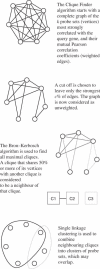Arabidopsis Co-expression Tool (ACT): web server tools for microarray-based gene expression analysis
- PMID: 16845059
- PMCID: PMC1538833
- DOI: 10.1093/nar/gkl204
Arabidopsis Co-expression Tool (ACT): web server tools for microarray-based gene expression analysis
Abstract
The Arabidopsis Co-expression Tool, ACT, ranks the genes across a large microarray dataset according to how closely their expression follows the expression of a query gene. A database stores pre-calculated co-expression results for approximately 21,800 genes based on data from over 300 arrays. These results can be corroborated by calculation of co-expression results for user-defined sub-sets of arrays or experiments from the NASC/GARNet array dataset. Clique Finder (CF) identifies groups of genes which are consistently co-expressed with each other across a user-defined co-expression list. The parameters can be altered easily to adjust cluster size and the output examined for optimal inclusion of genes with known biological roles. Alternatively, a Scatter Plot tool displays the correlation coefficients for all genes against two user-selected queries on a scatter plot which can be useful for visual identification of clusters of genes with similar r-values. User-input groups of genes can be highlighted on the scatter plots. Inclusion of genes with known biology in sets of genes identified using CF and Scatter Plot tools allows inferences to be made about the roles of the other genes in the set and both tools can therefore be used to generate short lists of genes for further characterization. ACT is freely available at www.Arabidopsis.leeds.ac.uk/ACT.
Figures



Similar articles
-
The Arabidopsis co-expression tool (ACT): a WWW-based tool and database for microarray-based gene expression analysis.Plant J. 2006 Apr;46(2):336-48. doi: 10.1111/j.1365-313X.2006.02681.x. Plant J. 2006. PMID: 16623895
-
MILANO--custom annotation of microarray results using automatic literature searches.BMC Bioinformatics. 2005 Jan 20;6:12. doi: 10.1186/1471-2105-6-12. BMC Bioinformatics. 2005. PMID: 15661078 Free PMC article.
-
SVD-based anatomy of gene expressions for correlation analysis in Arabidopsis thaliana.DNA Res. 2008 Dec;15(6):367-74. doi: 10.1093/dnares/dsn025. Epub 2008 Oct 17. DNA Res. 2008. PMID: 18931094 Free PMC article.
-
Co-expression analysis of metabolic pathways in plants.Methods Mol Biol. 2009;553:247-64. doi: 10.1007/978-1-60327-563-7_12. Methods Mol Biol. 2009. PMID: 19588109 Review.
-
Co-expression tools for plant biology: opportunities for hypothesis generation and caveats.Plant Cell Environ. 2009 Dec;32(12):1633-51. doi: 10.1111/j.1365-3040.2009.02040.x. Epub 2009 Aug 27. Plant Cell Environ. 2009. PMID: 19712066 Review.
Cited by
-
A transcriptional analysis of carotenoid, chlorophyll and plastidial isoprenoid biosynthesis genes during development and osmotic stress responses in Arabidopsis thaliana.BMC Syst Biol. 2011 May 19;5:77. doi: 10.1186/1752-0509-5-77. BMC Syst Biol. 2011. PMID: 21595952 Free PMC article.
-
GeneFriends: a human RNA-seq-based gene and transcript co-expression database.Nucleic Acids Res. 2015 Jan;43(Database issue):D1124-32. doi: 10.1093/nar/gku1042. Epub 2014 Oct 31. Nucleic Acids Res. 2015. PMID: 25361971 Free PMC article.
-
EDR1 physically interacts with MKK4/MKK5 and negatively regulates a MAP kinase cascade to modulate plant innate immunity.PLoS Genet. 2014 May 15;10(5):e1004389. doi: 10.1371/journal.pgen.1004389. eCollection 2014. PLoS Genet. 2014. PMID: 24830651 Free PMC article.
-
ImmuCo: a database of gene co-expression in immune cells.Nucleic Acids Res. 2015 Jan;43(Database issue):D1133-9. doi: 10.1093/nar/gku980. Epub 2014 Oct 17. Nucleic Acids Res. 2015. PMID: 25326331 Free PMC article.
-
Cre-lox univector acceptor vectors for functional screening in protoplasts: analysis of Arabidopsis donor cDNAs encoding ABSCISIC ACID INSENSITIVE1-like protein phosphatases.Plant Mol Biol. 2009 Aug;70(6):693-708. doi: 10.1007/s11103-009-9502-1. Epub 2009 Jun 6. Plant Mol Biol. 2009. PMID: 19499346 Free PMC article.
References
-
- Rhee S.Y., Beavis W., Berardini T.Z., Chen G.H., Dixon D., Doyle A., Garcia-Hernandez M., Huala E., Lander G., Montoya M., et al. The Arabidopsis Information Resource (TAIR): a model organism database providing a centralized, curated gateway to Arabidopsis biology, research materials and community. Nucleic Acids Res. 2003;31:224–228. - PMC - PubMed
-
- Toufighi K., Brady S.M., Austin R., Ly E., Provart N.J. The Botany Array Resource: e-Northerns, Expression Angling, and Promoter analyses. Plant J. 2005;43:153–163. - PubMed
-
- Zimmermann P., Hennig L., Gruissem W. Gene-expression analysis and network discovery using Genevestigator. Trends Plant Sci. 2005;10:407–409. - PubMed
Publication types
MeSH terms
Substances
LinkOut - more resources
Full Text Sources
Other Literature Sources
Molecular Biology Databases

